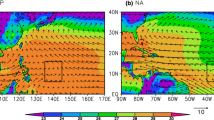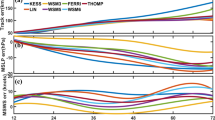Abstract
The sensitivity of the simulation of tropical cyclone (TC) size to microphysics schemes is studied using the Advanced Hurricane Weather Research and Forecasting Model (WRF). Six TCs during the 2013 western North Pacific typhoon season and three mainstream microphysics schemes–Ferrier (FER), WRF Single-Moment 5-class (WSM5) and WRF Single-Moment 6-class (WSM6)–are investigated. The results consistently show that the simulated TC track is not sensitive to the choice of microphysics scheme in the early simulation, especially in the open ocean. However, the sensitivity is much greater for TC intensity and inner-core size. The TC intensity and size simulated using the WSM5 and WSM6 schemes are respectively higher and larger than those using the FER scheme in general, which likely results from more diabatic heating being generated outside the eyewall in rainbands. More diabatic heating in rainbands gives higher inflow in the lower troposphere and higher outflow in the upper troposphere, with higher upward motion outside the eyewall. The lower-tropospheric inflow would transport absolute angular momentum inward to spin up tangential wind predominantly near the eyewall, leading to the increment in TC intensity and size (the inner-core size, especially). In addition, the inclusion of graupel microphysics processes (as in WSM6) may not have a significant impact on the simulation of TC track, intensity and size.
Similar content being viewed by others
References
Brutsaert, W., 1975. A theory for local evaporation (or heat transfer) from rough and smooth surfaces at ground level. Water Resour. Res., 11, 543–550, doi: 10.1029/WR011i004p00543.
Bu, Y. P., R. G. Fovell, and K. L. Corbosiero, 2014. Influence of cloud–radiative forcing on tropical cyclone structure. J. Atmos. Sci., 71, 1644–1662, doi: 10.1175/JAS-D-13-0265.1.
Bui, H. H., R. K. Smith, M. T. Montgomery, and J. Y. Peng, 2009. Balanced and unbalanced aspects of tropical cyclone intensification. Quart. J. Roy. Meteor. Soc., 135, 1715–1731, doi: 10.1002/qj.502.
Chan, K. T. F., and J. C. L. Chan, 2012. Size and strength of tropical cyclones as inferred from QuikSCAT data. Mon. Wea. Rev., 140, 811–824, doi: 10.1175/MWR-D-10-05062.1.
Chan, K. T. F., and J. C. L. Chan, 2013. Angular momentum transports and synoptic flow patterns associated with tropical cyclone size change. Mon. Wea. Rev., 141, 3985–4007, doi: 10.1175/MWR-D-12-00204.1.
Chan, K. T. F., and J. C. L. Chan, 2014. Impacts of initial vortex size and planetary vorticity on tropical cyclone size. Quart. J. Roy. Meteor. Soc., 140, 2235–2248, doi: 10.1002/qj.2292.
Chan, K. T. F., and J. C. L. Chan, 2015a. Global climatology of tropical cyclone size as inferred from QuikSCAT data. Int. J. Climatol., 35, 4843–4848, doi: 10.1002/joc.4307.
Chan, K. T. F., and J. C. L. Chan, 2015b. Impacts of vortex intensity and outer winds on tropical cyclone size. Quart. J. Roy. Meteor. Soc., 141, 525–537, doi: 10.1002/qj.2374.
Chavas, D. R., and K. A. Emanuel, 2010: A QuikSCAT climatology of tropical cyclone size. Geophys. Res. Lett., 37, L18816, doi: 10.1029/2010GL044558.
Chen, S.-H., and W.-Y. Sun, 2002. A one-dimensional time dependent cloud model. J. Meteor. Soc. Japan, 80, 99–118, doi: 10.2151/jmsj.80.99.
Donelan, M. A., B. K. Haus, N. Reul, W. J. Plant, M. Stiassnie, H. C. Graber, O. B. Brown, and E. S. Saltzman, 2004: On the limiting aerodynamic roughness of the ocean in very strong winds. Geophys. Res. Lett., 31, L18306, doi: 10.1029/2004GL019460.
Fovell, R. G., and H. Su, 2007: Impact of cloud microphysics on hurricane track forecasts. Geophys. Res. Lett., 34, L24810, doi: 10.1029/2007GL031723.
Fovell, R. G., K. L. Corbosiero, and H. C. Kuo, 2009. Cloud microphysics impact on hurricane track as revealed in idealized experiments. J. Atmos. Sci., 66, 1764–1778, doi: 10.1175/ 2008JAS2874.1.
Fovell, R. G., K. L. Corbosiero, A. Seifert, and K. N. Liou, 2010: Impact of cloud-radiative processes on hurricane track. Geophys. Res. Lett., 37, L07808, doi: 10.1029/2010GL042691.
Fudeyasu, H., and Y. Q. Wang, 2011. Balanced contribution to the intensification of a tropical cyclone simulated in TCM4: Outer core spin-up process. J. Atmos. Sci., 68, 430–449, doi: 10.1175/2010JAS3523.1.
Goerss, J. S., 2000. Tropical cyclone track forecasts using an ensemble of dynamical models. Mon. Wea. Rev., 128, 1187–1193, doi: 10.1175/1520-0493(2000)128<1187:TCTFUA> 2.0.CO;2.
Han, J., and H.-L. Pan, 2011. Revision of convection and vertical diffusion schemes in the NCEP Global Forecast System. Wea. Forecasting, 26, 520–533, doi: 10.1175/WAF-D-10-05038.1.
Heming, J., J. C. L. Chan, and A. M. Radford, 1995. A new scheme for the initialisation of tropical cyclones in the UK Meteorological Office global model. Meteorological Applications, 2, 171–184, doi: 10.1002/met.5060020211.
Hill, K. A., and G. M. Lackmann, 2009. Influence of environmental humidity on tropical cyclone size. Mon. Wea. Rev., 137, 3294–3315, doi: 10.1175/2009MWR2679.1.
Hong, S.-Y., and J.-O. J. Lim, 2006. The WRF Single-Moment 6-Class Microphysics Scheme (WSM6). Journal of the Korean Meteorological Society, 42, 129–151.
Hong, S.-Y., J. Dudhia, and S.-H. Chen, 2004. A revised approach to ice microphysical processes for the bulk parameterization of clouds and precipitation. Mon. Wea. Rev., 132, 103–120, doi: 10.1175/1520-0493(2004)132<0103:ARATIM>2.0.CO; 2.
Hong, S.-Y., Y. Noh, and J. Dudhia, 2006. A new vertical diffusion package with an explicit treatment of entrainment processes. Mon. Wea. Rev., 134, 2318–2341, doi: 10.1175/MWR3199.1.
Iacono, M. J., J. S. Delamere, E. J. Mlawer, M. W. Shephard, S. A. Clough, and W. D. Collins, 2008: Radiative forcing by long-lived greenhouse gases: Calculations with the AER radiative transfer models. J. Geophys. Res., 113, D13103, doi: 10.1029/2008JD009944.
Jiménez, P. A., J. Dudhia, J. F. González-Rouco, J. Navarro, J. P. Montávez, and E. Garćia-Bustamante, 2012. A revised scheme for the WRF surface layer formulation. Mon. Wea. Rev., 140, 898–918, doi: 10.1175/MWR-D-11-00056.1.
Kain, J., 2004. The Kain–Fritsch convective parameterization: An update. J. Appl. Meteor., 43, 170–181, doi: 10.1175/1520- 0450(2004)043<0170:TKCPAU>2.0.CO;2.
Kessler, E., 1995. On the continuity and distribution of water substance in atmospheric circulations. Atmospheric Research, 38, 109–145, doi: 10.1016/0169-8095(94)00090-Z.
Kimball, S. K., and M. S. Mulekar, 2004. A 15-year climatology of North Atlantic tropical cyclones. Part I: Size parameters. J. Climate, 17, 3555–3575, doi: 10.1175/1520-0442(2004)017<3555:AYCONA>2.0.CO;2.
Knaff, J. A., S. P. Longmore, and D. A. Molenar, 2014. An objective satellite-based tropical cyclone size climatology. J. Climate, 27, 455–476, doi: 10.1175/JCLI-D-13-00096.1.
Krishnamurti, T. N., R. Correa-Torres, G. Rohaly, and D. Oosterhof, 1997. Physical initialization and hurricane ensemble forecasts. Wea. Forecasting, 12, 503–514, doi: 10.1175/1520-0434(1997)012<0503:PIAHEF>2.0.CO;2.
Kurihara, Y., M. A. Bender, R. E. Tuleya, and R. J. Ross, 1990. Prediction experiments of Hurricane Gloria (1985) using a multiply nested movable mesh model. Mon. Wea. Rev., 118, 2185–2198, doi: 10.1175/1520-0493(1990)118<2185:PEOHGU>2.0.CO;2.
Leslie, L. M., and G. J. Holland. 1995. On the bogussing of tropical cyclones in numerical models: A comparison of vortex profiles. Meteor. Atmos. Phys., 56, 101–110, doi: 10.1007/BF01022523.
Leslie, L. M., J. F. Le Marshall, R. P. Morison, C. Spinoso, R. J. Purser, N. Pescod, and R. Seecamp, 1998. Improved hurricane track forecasting from the continuous assimilation of high quality satellite wind data. Mon. Wea. Rev., 126, 1248–1257, doi: 10.1175/1520-0493(1998)126<1248:IHTFFT>2. 0.CO;2.
Li, Q. Q., Y. Q. Wang, and Y. H. Duan, 2014. Effects of diabatic heating and cooling in the rapid filamentation zone on structure and intensity of a simulated tropical cyclone. J. Atmos. Sci., 71, 3144–3163, doi: 10.1175/JAS-D-13-0312.1.
Li, Q. Q., Y. Q. Wang, and Y. H. Duan, 2015. Impacts of evaporation of rainwater on tropical cyclone structure and intensity–A revisit. J. Atmos. Sci., 72, 1323–1345, doi: 10.1175/JAS-D-14-0224.1.
Li, X. L., and Z. X. Pu, 2008. Sensitivity of numerical simulation of early rapid intensification of hurricane Emily (2005) to cloud microphysical and planetary boundary layer parameterizations. Mon. Wea. Rev., 136, 4819–4838, doi: 10.1175/2008MWR2366.1.
Lin, Y.-L., R. D. Farley, and H. D. Orville, 1983. Bulk parameterization of the snow field in a cloud model. J. Climate Appl. Meteor., 22, 1065–1092, doi: 10.1175/1520-0450(1983)022 <1065:BPOTSF>2.0.CO;2.
Liu, K. S., and J. C. L. Chan, 2002. Synoptic flow patterns associated with small and large tropical cyclones over the western North Pacific. Mon.Wea. Rev., 130, 2134–2142, doi: 10.1175/ 1520-0493(2002)130<2134:SFPAWS>2.0.CO;2.
Merrill, R. T., 1984. A comparison of large and small tropical cyclones. Mon. Wea. Rev., 112, 1408–1418, doi: 10.1175/1520-0493(1984)112<1408:ACOLAS>2.0.CO;2.
Miyoshi, T., T. Komori, H. Yonehara, R. Sakai, and M. Yamaguchi, 2010. Impact of resolution degradation of the initial condition on typhoon track forecasts. Wea. Forecasting, 25, 1568–1573, doi: 10.1175/2010WAF2222392.1.
Rappaport, E. N., and Coauthors, 2009. Advances and challenges at the National Hurricane Center. Wea. Forecasting, 24, 395–419, doi: 10.1175/2008WAF2222128.1.
Rogers, E., T. Black, B. Ferrier, Y. Lin, D. Parrish, and G. DiMego, 2001: Changes to the NCEP Meso Eta Analysis and Forecast System: Increase in resolution, new cloud microphysics, modified precipitation assimilation, modified 3DVAR analysis. [Available online at http://www.emc.ncep.noaa.gov/mmb/mmbpll/eta12tpb/.]
Rogers, R., and Coauthors, 2006. The intensity forecasting experiment: A NOAA multiyear field program for improving tropical cyclone intensity forecasts. Bull. Amer. Meteor. Soc., 87, 1523–1537, doi: 10.1175/BAMS-87-11-1523.
Skamarock, W. C., and Coauthors, 2008: A description of the Advanced Research WRF version 3. NCAR Tech. Note NCAR/TN-4751STR, 113 pp. [Available online at http://www2.mmm.ucar.edu/wrf/users/docs/arw v3.pdf.]
Smith, R. K., C. W. Schmidt, and M. T. Montgomery, 2011. An investigation of rotational influences on tropical-cyclone size and intensity. Quart. J. Roy. Meteor. Soc., 137, 1841–1855, doi: 10.1002/qj.862.
Srinivas, C. V., R. Venkatesan, D. V. Bhaskar Rao, and D. Hari Prasad, 2007. Numerical simulation of Andhra severe cyclone (2003): Model sensitivity to the boundary layer and convection parameterization. Pure Appl. Geophys., 164, 1465–1487, doi: 10.1007/s00024-007-0228-1.
Sun, Y., Z. Zhong, and W. Lu, 2015. Sensitivity of tropical cyclone feedback on the intensity of the western Pacific subtropical high to microphysics schemes. J. Atmos. Sci., 72, 1346–1368, doi: 10.1175/JAS-D-14-0051.1.
Tao, W-K., J. J. Shi, S. S. Chen, S. Lang, P.-L. Lin, S.-Y. Hong, C. Peters-Lidard, and A. Hou, 2011. The impact of microphysical schemes on hurricane intensity and track. Asia-Pacific Journal of Atmospheric Sciences., 47, 1–16, doi: 10.1007/s13143-011-1001-z.
Tewari, M., and Coauthors, 2004. Implementation and verification of the unified Noah land surface model in the WRF model. Presented at the 20th Conference on Weather Analysis and Forecasting/16th Conference on Numerical Weather Prediction, Seattle, Wash., Amer. Meteor. Soc.
Tiedtke, M., 1989: A comprehensive mass flux scheme for cumulus parameterization in large-scale models. Mon. Wea. Rev., 117, 1779–1800, doi: 10.1175/1520-0493(1989)117<1779: ACMFSF>2.0.CO;2.
Torn, R. D., 2010. Performance of a mesoscale ensemble Kalman filter (EnKF) during the NOAA high-resolution hurricane test. Mon. Wea. Rev., 138, 4375–4392, doi: 10.1175/2010MWR3361.1.
Wang, Y. Q., 2002. An explicit simulation of tropical cyclones with a triply nested movable mesh primitive equation model-TCM3. Part II: Model refinements and sensitivity to cloud microphysics parameterization. Mon. Wea. Rev., 130, 3022–3036, doi: 10.1175/1520-0493(2002)130<3022:AESOTC>2. 0.CO;2.
Wang, Y. Q., 2009. How do outer spiral rainbands affect tropical cyclone structure and intensity? J. Atmos. Sci., 66, 1250–1273, doi: 10.1175/2008JAS2737.1.
Wang, Y. Q., 2012. Recent research progress on tropical cyclone structure and intensity. Tropical Cyclone Research and Review, 1, 254–275, doi: 10.6057/2012TCRR02.05.
Xu, J., and Y. Q. Wang, 2010a. Sensitivity of tropical cyclone inner-core size and intensity to the radial distribution of surface entropy flux. J. Atmos. Sci., 67, 1831–1852, doi: 10.1175/2010JAS3387.1.
Xu, J., and Y. Q. Wang, 2010b. Sensitivity of the simulated tropical cyclone inner-core size to the initial vortex size. Mon. Wea. Rev., 138, 4135–4157, doi: 10.1175/2010MWR3335.1.
Yang, M.-J., and L. Ching, 2005. A modeling study of Typhoon Toraji (2001): Physical parameterization sensitivity and topographic effect. Terrestrial, Atmospheric and Oceanic Sciences, 16, 177–213.
Yuan, J. N., X.D. Wang, Q.L. Wan, and C.X. Liu, 2007. A 28-year climatological analysis of size parameters for Northwestern Pacific tropical cyclones. Adv. Atmos. Sci., 24, 24–34, doi: 10.1007/s00376-007-0024-y.
Zhang, C. X., Y.Q. Wang, and K. Hamilton, 2011. Improved representation of boundary layer clouds over the southeast Pacific in ARW-WRF using a modified Tiedtke cumulus parameterization scheme. Mon. Wea. Rev., 139, 3489–3513, doi: 10.1175/MWR-D-10-05091.1.
Zhu, T., and D.-L. Zhang, 2006. The impact of the storm-induced SST cooling on hurricane intensity. Adv. Atmos. Sci., 23, 14–22, doi: 10.1007/s00376-006-0002-9.
Zou, X. L., and Q. N. Xiao, 2000. Studies on the initialization and simulation of a mature hurricane using a variational bogus data assimilation scheme. J. Atmos. Sci., 57, 836–860, doi: 10.1175/1520-0469(2000)057<0836:SOTIAS>2.0.CO;2.
Author information
Authors and Affiliations
Corresponding author
Rights and permissions
About this article
Cite this article
Chan, K.T.F., Chan, J.C.L. Sensitivity of the simulation of tropical cyclone size to microphysics schemes. Adv. Atmos. Sci. 33, 1024–1035 (2016). https://doi.org/10.1007/s00376-016-5183-2
Received:
Revised:
Accepted:
Published:
Issue Date:
DOI: https://doi.org/10.1007/s00376-016-5183-2




